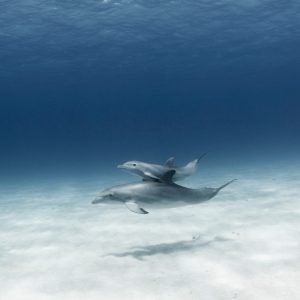
In recent years, whale strandings associated with nearby naval sonar use have increased public concern about the impacts of human-caused noise on marine mammals, especially sound-sensitive whales and dolphins.
Whales and dolphins rely heavily on their sense of hearing to navigate, locate prey, avoid predators, and communicate in the ocean environment. This is because sound travels very well in water, whereas light only penetrates for a short way below the water’s surface.
Clearly, the growing amount of human-caused noise in the ocean may be a growing problem for sound-sensitive creatures. Marine mammals and other marine species can suffer not only hearing damage when exposed to loud noises, but also other physical and psychological harm. For example, exposure to an unexpected and unnatural loud noise could startle a deep-diving whale, causing it to bolt for the surface in a panic. Such a rapid ascent could lead to bubbles forming in the tissues (a condition known in human divers as “the bends”) and then to a stranding.
Noise sources
Mid-frequency (MF) sonars have been commonly deployed on naval vessels since the 1960s. Relatively new low frequency sonars (including Low Frequency Active or LFA sonar) are now in limited use. The U.S. Navy claims LFA sonar can detect today’s quieter submarines more reliably and at a greater distance than is possible with MF sonars. All active sonars emit a noise pulse or “ping”—in the case of LFA sonar, a “ping” is six to 100 seconds in duration. These sound pulses bounce off a target (such as a submarine) and return as echoes that are detected by underwater microphones, called hydrophones. Hydrophones also listen for sounds actively generated by ships, submarines and even whales.
Evidence is mounting that MF sonars can harm at least certain species of whales—to the point of causing fatal mass strandings—and has probably been doing so for decades. However, its range of potential impact is smaller than LFA sonar (the lower the frequency, the farther a sound travels through water), although there are many more MF sonars deployed throughout the ocean. LFA sonar’s relatively limited use has yet to be associated with direct harm to marine mammals, but its greater range and sustained loudness could ultimately affect a far greater number of marine animals, especially if the number of LFA sonars increases.
Other human-made noise sources are also loud and could be harmful in different ways. For example, shipping noise from the vast fleet of trans-oceanic container ships, tankers, and other large vessels is low frequency and pervasive in many parts of the ocean. While it is unlikely to cause acute physical harm (other than long-term hearing loss), it may “mask” important communication signals from large whales whose vocalizations are in the low frequency range.
Seismic airguns, used by the petroleum industry to locate pockets of oil or natural gas within the ocean floor and by researchers to locate sub-surface geological features, are like underwater gun blasts and at times can be heard throughout entire ocean basins. Such sounds can be acutely harmful to nearby animals, but may also repeatedly startle or disturb them to the point where they abandon important habitat.
Other human-made noise sources with the potential to harm marine species include demolition and military explosives and “seal scarers.”
Better safe
Marine noise is one of many environmental threats facing marine life, but its impacts are harder to identify than those from chemical pollution or debris entanglement. Noise impacts may also result in fewer outright deaths (although the science on this is still not clear), but may be more insidious. Many noise impacts, including stress, may be sub-lethal yet significant, reducing reproductive success or shortening life spans. Therefore, it is vital that management and mitigation of this threat be pro-active and precautionary.
Research is urgently needed to clarify the ways in which human-caused noise can affect marine animals, but until the science catches up, laws and regulations should be enacted that give the benefit of the doubt to wildlife and slow the spread of human-caused noise in the oceans.
